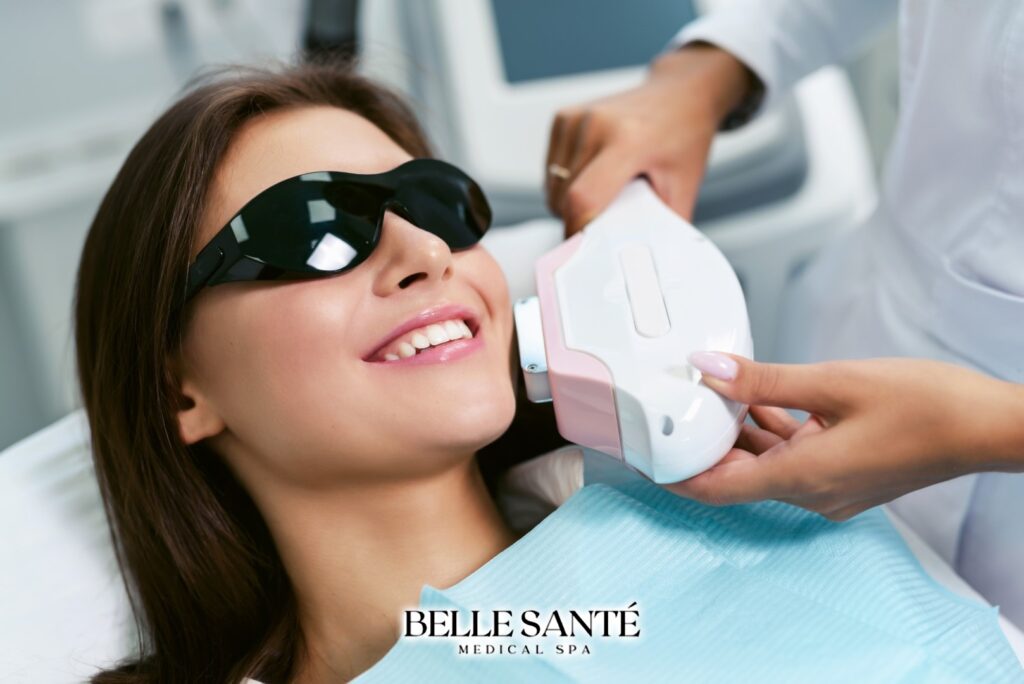Exposure to various environmental factors like sunlight, harsh cleansers, pollution, and the natural aging process can lead to skin dullness and the development of wrinkles, which are certainly not our favorite skin conditions. However, Intense Pulsed Light (IPL) offers a solution to these concerns. In this comprehensive article, we’ll delve into the world of IPL photofacial treatments, exploring their effectiveness, benefits, and scientific principles.
What is an IPL Photofacial?
An IPL (Intense Pulsed Light) photofacial, also known as IPL therapy or IPL skin rejuvenation, is a non-invasive cosmetic procedure used to improve the appearance of the skin. It targets various skin concerns such as sun damage, age spots, freckles, rosacea, uneven skin tone, and vascular lesions. The treatment involves the use of short bursts of high-intensity light to rejuvenate the skin, resulting in a more youthful appearance characterized by improved firmness and an even tone and texture. Despite its seemingly magical effects, IPL therapy is grounded in scientific principles.
How Does an IPL Photofacial Work?
Let’s break down the components and processes involved in an IPL photofacial:
- Light Source:
- IPL devices emit multiple wavelengths of light that target various chromophores in the skin, such as melanin (pigment) and hemoglobin (blood vessels).
- Unlike lasers that emit a single, focused wavelength of light, IPL devices deliver a broad spectrum of light, allowing them to address multiple skin concerns simultaneously.
- Targeted Concerns:
- Sun Damage:
- IPL targets excess melanin in the skin, reducing the appearance of sunspots, age spots, and freckles caused by sun exposure.
- Rosacea:
- IPL helps reduce redness and flushing associated with rosacea by targeting the blood vessels that contribute to these symptoms.
- Uneven Skin Tone:
- IPL improves skin texture and tone by targeting pigmented areas and promoting collagen production, resulting in smoother, more even skin.
- Vascular Lesions:
- IPL treats visible blood vessels, spider veins, and other vascular lesions by targeting hemoglobin in the blood vessels, causing them to coagulate and eventually fade from view.
- Acne:
- IPL utilizes light flashes over the treated area, targeting biochemical responses that eventually kill the bacteria within the pores.
- Procedure:
During an IPL photofacial treatment session:
- Consultation: A skincare professional assesses your skin concerns, medical history, and treatment goals to determine if IPL photofacial is suitable for you.
- Precise Light Delivery: The IPL device delivers controlled bursts of light energy, penetrating the skin’s deeper layers without harming the epidermis.
- Collagen Stimulation: The light energy stimulates collagen production, enhancing skin firmness and texture.
- Minimal Downtime: IPL photofacial boasts minimal downtime, making it an attractive option for combating aging signs and reversing sun damage.
Benefits of an IPL Photofacial
- Reduced Age Spots and Sun Damage: IPL treatments target excessive pigmentation, reducing age spots, sunspots, and freckles.
- Reduction in Redness: IPL can simultaneously reduce redness caused by broken capillaries, rosacea, and general facial flushing.
- Improved Skin Texture: Fine lines, wrinkles, and overall skin texture benefit from IPL therapy.
- Scientifically Grounded: While it may seem like magic, IPL’s effectiveness is rooted in scientific principles.
In summary, IPL photofacials offer a versatile solution for various skin concerns. Whether you’re battling sun damage, uneven skin tone, or vascular lesions, IPL therapy can rejuvenate your skin and restore its youthful glow. With minimal downtime and impressive results, IPL is a safe and effective choice for those seeking skin improvement without surgery.
Remember, your skin deserves the best—consider an IPL photofacial for a radiant transformation!
Disclaimer: This article provides general information and should not replace professional medical advice.


